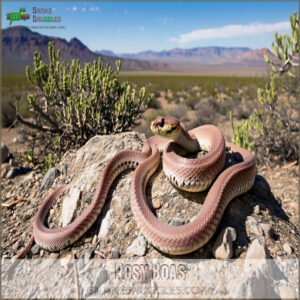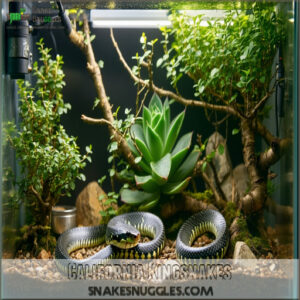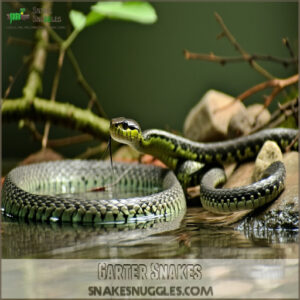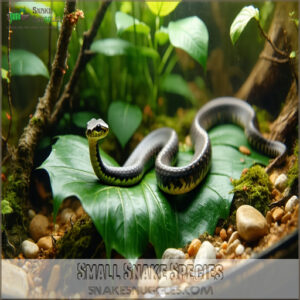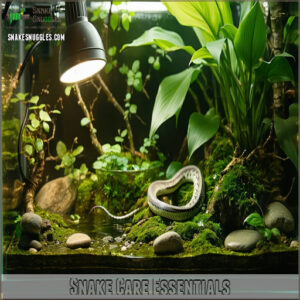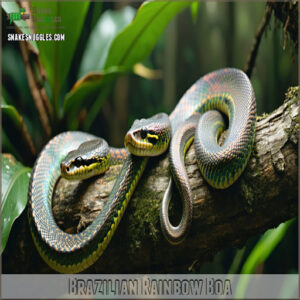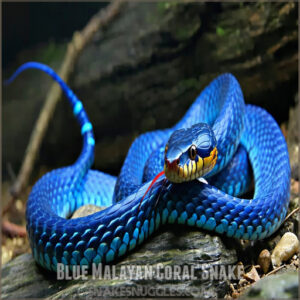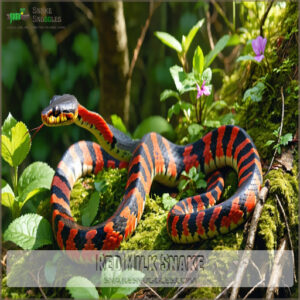This site is supported by our readers. We may earn a commission, at no cost to you, if you purchase through links.

The hognose snake charms with its upturned snoot and puppy-like personality, while corn snakes dazzle with vibrant patterns that’ll make your Instagram pop.
Ball pythons, nature’s living stress balls, love gentle handling and come in stunning morphs.
For the size-conscious, consider the Barbados threadsnake – smaller than a pencil.
Brazilian rainbow boas steal the show with scales that shimmer like precious gems under light.
Each species brings its own brand of adorable, from the calm carpet python to the curious rosy boa, and these scaly sweethearts might just change everything you thought about snakes with their vibrant patterns.
Table Of Contents
- Key Takeaways
- Cutest Pet Snake Breeds
- Popular Snake Breeds
- Small Snake Species
- Snake Care Essentials
- Beautiful Snake Colors
- Frequently Asked Questions (FAQs)
- What is the cutest snake breed?
- Are snakes cute pets?
- What kind of snakes make good pets?
- Are snakes cute?
- What is the smallest snake breed?
- What are adorable snakes called?
- What is the cutest snake to have as a pet?
- What is the most cuddly pet snake?
- What is the prettiest snake?
- What is the calmest pet snake?
- Conclusion
Key Takeaways
- Hognose snakes make ideal first-time pets with their upturned snouts, docile nature, and manageable size of under two feet – they’ll thrive on a simple diet of pre-killed mice and love burrowing in their habitat.
- You’ll find ball pythons to be the most cuddly option among pet snakes, as they’re gentle, rarely grow beyond 5 feet, and come in numerous stunning color morphs that showcase unique patterns and traits.
- Corn snakes will dazzle you with their vibrant red-orange coloring and gentle temperament – they’re easy to handle, rarely bite, and their basic care requirements make them perfect for beginners.
- For the space-conscious, you can’t go wrong with the Barbados threadsnake or rosy boa – they stay small, adapt well to compact habitats, and still offer the fascinating behaviors and personalities that make snakes such engaging pets.
Cutest Pet Snake Breeds
You’re going to love these snakes—they’re small, colorful, and full of personality.
From the adorable Hognose with its upturned nose to the friendly Corn Snake, these breeds are as cute as they’re easy to care for.
Hognose Snakes
Hognose snakes are the ultimate cute pet snakes, thanks to their upturned snouts and wide, curious eyes.
These docile charmers love burrowing, adding personality to their snake habitat.
Many hognose snakes remain small, rarely exceeding two feet in length, making them ideal small pet snakes.
Western hognose snake care is simple—they thrive on a hognose diet of pre-killed mice.
Easy to handle and mild-mannered, this pet snake breed is perfect for beginners seeking adorable companionship!
Corn Snakes
Corn snakes are one of the cutest pet snake breeds, thanks to their vibrant red-orange backs and gentle nature.
They’re easy to handle, rarely bite, and thrive in a cozy Corn Snake Habitat.
Snake Feeding is simple—pinky mice are their favorite!
With their curious Snake Behavior and docile temperament, corn snakes are perfect for beginners seeking cute pet snakes.
For more information on these adorable reptiles, research the cutest pet snakes to discover their unique characteristics.
Ball Pythons
Ball pythons are the teddy bears of cute snake breeds! These docile, even-tempered beauties grow to 3–5 feet, making them perfect for cozy Python Habitat setups.
With endless Python Morphs showcasing stunning patterns, they’re a dream for collectors. Ball Handling is easy—just support their body gently.
Ball Feeding? Simple! Frozen-thawed rodents work best. Truly adorable pet snake breeds!
Understanding ball python genetics is key to appreciating their unique traits.
African Ball Pythons
African ball pythons are a top pick among cute pet snakes, thanks to their calm nature and adorable ball patterns.
Native to an African habitat, these snakes thrive with proper Ball Python care.
They’re easygoing and love curling into a ball when shy.
Understanding ball python morphs is essential for their care.
- Size: 3–5 feet
- Lifespan: 25–30 years
- Diet: Small mammals
- Behavior: Gentle and curious
Popular Snake Breeds
You’ll love how popular snake breeds like Carpet Pythons and Rosy Boas bring beauty and personality to your home.
These snakes are easy to care for, fun to watch, and perfect for beginners or experienced keepers alike!
Carpet Pythons
Carpet pythons are like the gentle giants of cute pet snakes. They’re calm, curious, and stunning to look at with their intricate patterns.
These fascinating reptiles exhibit unique hunting tactics. They can grow up to 10 feet, making them a showstopper in your Python Habitat.
Their Reptile Behavior is fascinating, and they thrive on proper Snake Feeding routines. Check out their features below!
| Feature | Details |
|---|---|
| Size | 4-10 feet |
| Lifespan | 20-30 years |
| Colors/Patterns | Tan with unique designs |
| Personality | Calm and curious |
| Feeding | Rats |
Rosy Boas
Rosy boas are small, friendly pet snakes that are easy to care for and perfect for beginners.
These cute pet snakes are known for their calm nature and stunning colors.
Here’s why they’re a favorite:
- Boa Habitat: Simple setups with warm, dry environments.
- Boa Feeding: Small rodents once a week.
- Snake Handling: Tolerates gentle handling beautifully!
California Kingsnakes
California Kingsnakes are a real treat for snake lovers.
These friendly pet snakes are known for their striking striped patterns and curious snake behavior.
They’re small pet snakes, easy to handle, and thrive in a secure Kingsnake habitat.
Plus, their varied Kingsnake diet makes care simple.
Check out the table below for quick facts:
| Feature | Details |
|---|---|
| Length | 3-5 feet |
| Temperament | Calm and curious |
| Diet | Rodents, small birds |
Garter Snakes
Garter snakes are some of the cutest pet snakes, perfect for beginners.
Their Garter Habitat is simple, just include some water—these little guys love it.
Known for their gentle Snake Behavior, they rarely bite and are easy to handle.
A Pet Garter’s diet usually consists of insects, small fish, or earthworms.
Plus, search for cute snake pictures—their stripy patterns are adorable!
Small Snake Species
If you’re looking for adorable snakes that don’t take up much space, small species are perfect.
They are tiny cuties like the Barbados Threadsnake and Anthill Python that will make you smile with their charm and manageable size!
Barbados Threadsnake
If you’re smitten with tiny species, the Barbados Threadsnake is pure mini fauna magic!
This incredible creature, smaller than a pencil, thrives in sandy Threadsnake habitats.
Perfect for reptile research enthusiasts, it showcases nature’s brilliance. While not a typical pet, its role in snake conservation is priceless.
Imagine spotting one—you’d need sharp eyes and the cutest pet snake breeds list handy!
Brahminy Blind Snake
The Brahminy Blind Snake is a tiny wonder, often mistaken for a wiggly worm.
Native to Asia and Africa, this small species grows just 2-6 inches long.
Masters of burrowing techniques, they live in sandy soils or gardens.
Despite being blind, their snake behavior is fascinating.
- Tiny snake species: 2-6 inches long
- Brahminy habitat: sandy soil
- Parthenogenic (all-female species)
- Gentle, harmless snake
Dwarf Adder
Next, let’s meet the Dwarf Adder—one of the cutest small snake species out there.
Found in southern Africa, this tiny viper grows just 7.9–11 inches long, making it perfect for pet snake pictures.
While its size is charming, don’t forget about venom safety.
Their stunning patterns make them stand out, but they’re better admired than handled closely.
Anthill Python
The Anthill Python, one of the cutest small species, is perfect for beginners.
These tiny snakes, known for their curious burrowing behavior, grow to just 2-4 feet. With their slender bodies and tame personalities, they’re a joy to handle.
A proper Python habitat is key for their well-being.
Explore their charm in pet snake pictures showcasing these cute snakes.
When choosing a pet snake, consider the benefits of small pet snakes to make sure a great experience.
Snake Care Essentials
Taking care of your snake is easier than you’d think, but it’s all about getting the basics right.
From setting up a cozy habitat to nailing feeding routines, you’ll keep your scaly buddy happy and healthy!
Setting Up Habitat
Creating a cozy home for your snake breeds feels like decorating for a tiny roommate! Start with these basics:
- Snake Enclosures: Pick a secure tank-sized for your cute pet snakes.
- Substrate Choices: Use paper, aspen, or coconut bedding—soft yet practical.
- Heating Options: Snakes love warmth; under-tank heaters work great.
- Lighting Systems: Keep lighting low; snakes don’t need sunbathing lamps!
Proper snake care involves understanding snake enclosure requirements to maintain a healthy environment.
Feeding Options
Feeding your pet reptiles isn’t tricky, but it’s fascinating!
Snakes typically eat live prey or frozen food, depending on their habits.
A proper feeding schedule guarantees balanced snake nutrition.
Meal size matters—make sure it suits their body width.
Popular diets for the cutest pet snake breeds include pinky mice.
Snake diets are simple but important for great pet snake care!
Understanding proper snake food options is essential for a healthy pet, including the use of snake food sources.
Handling Techniques
When it’s time to handle the cutest pet snakes, like Hognose Snakes or Ball Pythons, keep it simple and gentle.
Always use a safe grip and support their body—they’re not ropes! Avoid Snake Restraint; they’re delicate, not wrestlers.
Pet snake handling gets easier with handling tools if needed. You’ll bond quickly with your cute pet reptiles!
Effective snake handling requires proper snake handling tools to guarantee safety.
Health Checks
Keeping your slithery buddy healthy’s a breeze if you’re vigilant.
Clean their enclosure regularly to avoid nasty snake diseases. Watch for strange behavior—refusing food or dull skin might mean health risks.
Schedule vet visits for checkups and parasite control. Good nutrition advice? Feed what suits their species.
Happy snakes mean smiles all around—because cutest pet snake breeds deserve extra love, and a clean environment is essential for their health, which can be maintained by clean habits and regular vet visits.
Beautiful Snake Colors
Snake colors can be jaw-droppingly gorgeous, from the shimmering rainbow shine of the Brazilian Rainbow Boa to the striking green of the Emerald Green Pit Viper.
Whether it’s bold patterns or bright hues, these snakes show nature’s artistic side in the coolest way!
Brazilian Rainbow Boa
The Brazilian Rainbow Boa is a true showstopper! Its iridescent scales shimmer like a living rainbow, making it one of the most colorful pet snakes around.
Known for their beauty and calm nature, they thrive in a warm, humid boa habitat.
These cute pet snakes are loved for their unique rainbow patterns. Absolutely stunning, right?
Emerald Green Pit Viper
The striking Emerald Green Pit Viper showcases nature’s most dazzling green patterns, making it a sight you won’t forget.
With its lime-green scales and bright yellow belly, this stunning creature’s got looks that’ll make your jaw drop.
While it’s not your typical cute pet snake (it’s venomous!), you can’t help but admire its gorgeous coloring from a safe distance.
Blue Malayan Coral Snake
Among the cutest pet snake breeds, the Blue Malayan Coral Snake‘s stunning appearance will take your breath away.
This gorgeous reptile sports a deep blue body with light blue or white stripes, topped off with a coral-red head and tail.
While its colors make for amazing snake pictures, remember it’s venomous – so you’ll want to admire these unique color morphs from a safe distance.
Red Milk Snake
While the Blue Malayan Coral Snake dazzles with its deep blues, you’ll fall head over heels for the Red Milk Snake’s stunning scarlet display.
These cutest pet snakes showcase nature’s artistry with their eye-catching patterns:
- Bright scarlet red base that’ll make your heart skip a beat
- Yellow-beige patches outlined in black, like a living masterpiece
- Distinctive checkered patterns that change as they move
You’ll spot these cute snake breeds in forests, meadows, and even backyards, which is a testament to their adaptability and the beauty of nature’s artistry.
Frequently Asked Questions (FAQs)
What is the cutest snake breed?
You’ll fall in love with the Hognose Snake.
They’re number one for cuteness with their adorable upturned snout, big puppy-dog eyes, and charming personality.
Plus, they come in beautiful colors like blue and tan, and have a charming personality.
Are snakes cute pets?
Like diamonds in a jeweler’s case, snakes can make surprisingly adorable pets.
You’ll find they’re gentle, fascinating creatures with unique personalities.
They’re low-maintenance companions that’ll curl up contentedly in your care.
What kind of snakes make good pets?
You’ll love Ball Pythons, Corn Snakes, or Hognose Snakes as pets.
They’re gentle, easy to handle, and perfect for beginners.
They don’t need much space and can live up to 30 years.
Are snakes cute?
Shimmering like living jewels, snakes can be surprisingly adorable.
You’ll find their curious eyes, gentle personalities, and graceful movements quite charming.
They’re nature’s works of art, each with unique patterns and endearing behaviors.
What is the smallest snake breed?
You’ll be amazed to learn that the Barbados Threadsnake is the world’s tiniest snake – it’s barely the size of a quarter.
The Brahminy Blind Snake follows as a close second, reaching only 4 inches.
What are adorable snakes called?
You’ll find several snake breeds that’ll make your heart melt.
The Hognose, Corn Snake, and Ball Python are known for their cute upturned noses, large innocent eyes, and adorable habits like curling into balls.
What is the cutest snake to have as a pet?
Ever wondered about the perfect scaly companion?
You’ll adore the Hognose Snake with its upturned snout and big eyes.
They’re gentle, stay small, and come in beautiful colors like blue, tan, and red.
What is the most cuddly pet snake?
You’ll love Ball Pythons as your cuddly companion.
They’re gentle giants who’ll wrap around your arm like a living bracelet.
Their docile nature and love for warmth make them perfect snuggle buddies.
What is the prettiest snake?
You’d think beauty’s subjective, but the Brazilian Rainbow Boa steals the show with its iridescent scales that shimmer like diamonds.
Their natural rainbow hues catch light in ways that’ll make you gasp in wonder.
What is the calmest pet snake?
The Rosy Boa is your best bet for a mellow snake companion.
You’ll love how they rarely bite and stay calm during handling.
They’re perfect first-time pets, living up to 25 years, and are a mellow snake companion.
Conclusion
Whether you’re drawn to the adorable snoot of a hognose or mesmerized by the rainbow boa’s jewel-like scales, these cutest pet snake breeds will capture your heart.
You’ll discover that snakes aren’t just reptiles – they’re fascinating companions with unique personalities.
From the pocket-sized Barbados threadsnake to the gentle ball python, there’s a perfect scaly friend waiting for you.
Ready to explore these charming creatures? Your next pet might just be a snake!
- https://allanspetcenter.com/the-top-10-best-snake-pets-to-own/
- https://www.reddit.com/r/snakes/comments/xwuls0/what_are_good_snake_breeds_that_like_to_be_handled/
- https://www.thesprucepets.com/snake-species-1239472
- https://www.discovermagazine.com/planet-earth/7-of-the-cutest-snakes-that-may-slither-their-way-into-your-heart
- https://www.britannica.com/animal/snake



